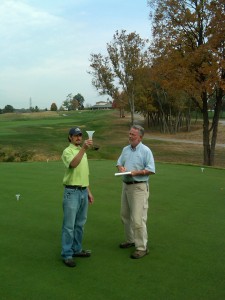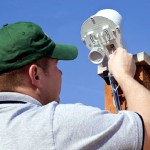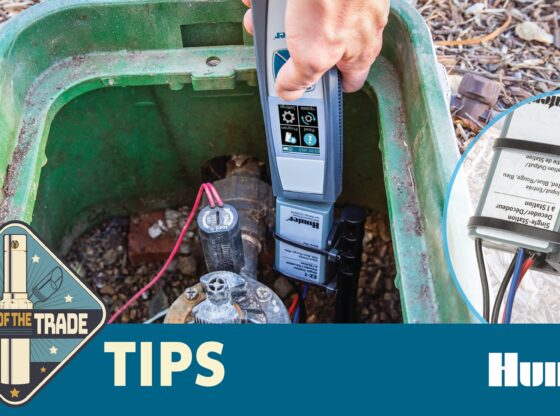Let’s face it; nobody wants to invest money into an irrigation system. Irrigation is not exciting, it doesn’t give you much to brag about, and in fact you hardly ever see it operate. Some sport turf operators call their irrigation system the “Irritation System”.
But, if you desire a healthy stand of turf that can look good and have great play conditions even after a season of play, you MUST have an efficient irrigation system. Irrigation is an indispensable tool to establish and maintain healthy turf on a sport field. Done right irrigation makes your life easier while having excellent quality turf.
As with any tool, it matters that it is the “right” tool for the job. We seek tools that provide the best task efficiency. Efficiency applies to both operations and resources.
Operationally we want the tool that allows the needed tasks to be accomplished quickly at the quality level we desire. Concerning resources we want to minimize the amount consumable supplies to accomplish the task.
Back to irrigation; we want a system that completes the desired irrigation job reliably with the least amount of labor, water, and/or energy. A good way to measure “Efficient Irrigation” is the lifespan cost to purchase and operate a system.
Purchasing Efficient Irrigation
Let’s deal with the big bug-a-boo right off: cost. In 1974 I was building my collection of tools. My father went with me to Sears to buy a hammer. After selecting one, he asked why I picked it. I told him it was the cheapest and I was too poor to buy a better one. He replied by saying, “Poor people can’t afford to buy cheap.” I bought a better hammer and still use it today.
Cute story, but the moral is to buy the tool that will do the job and do it for the lifespan you desire. If money for irrigation is an issue, as it always is, buy what you can. However, have a plan of where you want to end up and only buy what will become part of that goal. The moral is to have a long term irrigation plan.
Most sport turf operators run on challenging budgets. Worse, improving the property often means no increase in revenues. Funding improvements from cost savings is a prime method. Operators must master using the international language of $$$. Fortunately, newer product and methods can help save resources, freeing money to improve inefficiencies. That’s how you stretch a tight budget.
Treat irrigation like any other major asset necessary for your operation. Initial investment is large and it’s hard to change once invested. Irrigation is a long term asset so look at the total lifespan.
Here are two key aspects that produce efficient Irrigation; High DU and Smart Control. Getting both right means all the small stuff necessary is handled to reduce water, energy, and labor costs. The other benefit is your system can be described as “conserving”.
High DU

Distribution Uniformity (DU) is the master’s mark of good irrigation. DU is measured by a ratio calculated from field gathered collection cup data. Great DU is more than 0.80, good is more than 0.70.
High DU means your irrigation system applies a nearly uniform application of water, minimizing wet or dry spots. High DU systems reduce water wastage, system runtime, power consumption, turf diseases, chemical usage, and run-off. An additional benefit is tighter control of your turf play conditions.
High DU is accomplished by:
Good Design -The proper sprinkler with the proper nozzle laid out at the best spacing and operating at the proper pressure. This is up to the designer.
Good Installation -The system is installed according to design.
Good Maintenance – A great irrigation system will become a poor system if basic maintenance is not performed.
Operating Efficient Irrigation
Smart Control

A high DU system can still be operated inefficiently. Thus wasting a lot of water, time, energy, chemicals, etc. Technology has risen to fill the void and it doesn’t cost much more than old fashioned control. Use it!
Smart Control refers to a control system utilizing site based sensors to determine irrigation water requirements. Your control system irrigates to what is needed by your turf at that moment. Generally, saves about 30% of the water compared to old fashioned control.
Example: Irrigating 1 acre of turf around Dayton, Ohio will save up to $1,100 per year in water cost if the system has DU higher than .75 and uses Smart Control. If pumps are involved there would be about $165 in electrical savings as well.
Total Lifespan Cost
Hardware Investment
Includes the cost to have a system designed and installed. Typically a large upfront cost that should be broken into annual amounts for analysis over expected lifespan of the system. A well-engineered and installed sport turf irrigation system will last 20 to 30 years if given decent maintenance and some periodic updates.
Operational Costs
The big costs to consider are water, labor, and electricity. Water and electrical costs are found on your water and power bills. If you don’t buy water then it’s nothing, but don’t forget the electrical costs to pump it.
Labor is all labor allocated or used to operate the system. Yes, your time has a cost. Add it in to your total cost calculations. The real value of your time is “lost opportunity”. What could you have done with the 20 hours per year used to manually adjust irrigation schedules if your controller did it automatically? 20 hours to put into improvements elsewhere or just to regain for your personal life.
Maintenance Costs
Fix the little things before they become big. Maintenance will involve some material costs, but is mostly a labor issue. Factor how many hours per year you expect to invest to keep the system functioning as a high DU system.
Maintenance may also mean minor upgrades through the years. Perhaps you replace the sprinklers in year 12, well add that in. Maybe your pump needs upgraded or you want to update your controller.
Adding up all the outlays and dividing over the lifespan gives you an annual amount. If the analysis is done every 2-3 years, increasing cost may point out the time for an upgrade or replacement.
Efficient Irrigation Analysis
Such examination has a few uses. You can use the numbers to justify upgrades or replacements, plan for an irrigation system budget, evaluate conservation upgrades, etc.
Efficiency is a measure of how much output was generated from whatever input was provided. Numbers don’t lie. Performing a true analysis includes all input, not just the purchase price. The numbers also illustrate areas you can do better.
Obviously there is more to it than explained here. That’s where irrigation professionals can help. Seek those with irrigation and financial education, certifications, years of experience, and good peer recommendations.
Analyzing the (total) lifespan cost of your system is how to determine if you truly practice “efficient irrigation.”












I really liked the advice about poor people can’t afford the cheapest. I’ve bought cheap stuff before and come to find that it breaks in a couple of weeks. It’s a real bummer. I think something as intricate as an irrigation system should probably have more quality and durability. Great advice, thanks!
Irrigation systems with sensors is a great way to make sure your yard is watered just enough to maintain that healthy look. Great advice here!
Thanks for the information on efficient irrigation for turf! We’re adding some to our property and I want to make sure that we conserve water as much as possible. I’ll make sure that we get a good design and good maintenance on the irrigation. How much water does turf need in a really dry climate?
I love the point you made about buying quality and not just the cheapest one. If you go cheap on an irrigation system, you will be regretting it as soon as you are repairing it. I agree with you and would figure out the goals I have and only buy a system that goes with those goals.
That is interesting, I never considered how irrigation systems might change for sport turf. I can see that it would be really important to have a well design watering system. Is the maintenance process different for sports turf? What would you recommend to keep it working at it’s best?
Change is constant! Maintenance is important for all irrigation systems. The environment is harsh, especially on sport turf. At least once a season observe each zone operate and note the little things that need fixed up. Tilted sprinklers, plugged nozzles, needed adjustments, etc. Often system run at night and many efficiency issues go unnoticed. Fixing the little things as they arise reduce costly and time consuming repairs later on. It also keeps the system in water conserving condition. Maintenance is very much the same for any irrigation systems, just differing components.
I have a residential arboretum in North end of Columbus Ohio of about 2/3 acre with an existing irrigation system with 4 programs, 12 zones, Rainbird system. The company who installed it in 1998 and maintained it has retired. Do you service a system like this?
No, we are a supply house. However, contractors who do such work are our customers. If you are acceptable, I will have our Columbus Territory Manager, Joe Boff, get a couple good contractors servicing your area to contact you. I have your email, maybe a phone number?